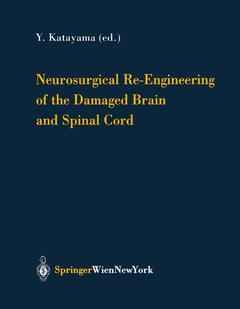Neurosurgical Re-Engineering of the Damaged Brain and Spinal Cord, 2003 Acta Neurochirurgica Supplement Series, Vol. 87
Langue : Anglais
Coordonnateur : Katayama Yoichi

This volume is the second in a new series of pro The task carried out through the collaboration of ceedings covering the official scientific meetings of the neurosurgeons and specialists in neurorehabilitation Neurorehabilitation Committee of the World Federa cannot be viewed simply as a restoration of function or tion of Neurosurgical Societies (WFNS). The first reconstruction of structure. Recent advances in neu scientific meeting of the WFNS Neurorehabilitation roimaging techniques have begun to demonstrate that Committee was held successfully in Munster, Ger it involves extensive functional and structural reorga many, in 2000 under the auspices of Professor Klaus nization of neural networks within the brain and R. H. von Wild. The proceedings of that meeting probably the spinal cord. On this basis, we felt that it (Functional Rehabilitation in Neurosurgery and Neu might be more appropriate to refer to such activities as rotraumatology) were published as a supplement to re-engineering of the damaged brain and spinal cord. Acta Neurochirurgica (volume 79, 2001). This first In order to encapsulate such a concept, the second scientific meeting highlighted the important role scientific meeting was entitled the Second Interna played by neurosurgeons in neurorehabilitation be tional Symposium on Neurosurgical Re-engineering of at an early period after brain or spinal cord the Damaged Brain and Spinal Cord (NRDBS'02). ginning damage.
Prolonged coma, minimally conscious state and persistent vegetative state.- Control of sleep and wakefulness by brainstem monoaminergic and cholinergic neurons.- Electrical treatment of coma via the median nerve.- Regaining consciousness for prolonged comatose patients with right median nerve stimulation.- DBS therapy for a persistent vegetative state: ten years follow-up results.- Clinical study on effect of HBO plus electric stimulation on treatment for the vegetative state.- Effects of musicokinetic therapy and spinal cord stimulation on patients in a persistent vegetative state.- Clinical application of the drug pump for spasticity, pain and restorative neurosurgery.- Intrathecal drug delivery 2002.- Clinical application of drug pump for spasticity, pain, and restorative neurosurgery: other clinical applications of intrathecal baclofen.- Intrathecal baclofen therapy; patient selection & team approach.- Current concepts and strategies of early neurorehabilitation.- New development of functional neurorehabilitation in neurosurgery.- Successful treatment by spinal cord stimulation for gait disturbance in a patient with diffuse axonal injury.- Functional electrical stimulation (FES) for spinal cord injury.- Functional imaging in neurosurgery and neurorehabilitation.- Bold functional MRI may overlook activation areas in the damaged brain.- Acetazolamide vasoreactivity in persistent vegetative state and vascular dementia evaluated by transcranial harmonic perfusion imaging and Doppler sonography.- Impairment of motor function after frontal lobe resection with preservation of the primary motor cortex.- Rehabilitation technique facilitates association cortices in hemiparetic patients: functional MRI study.- Neurosurgical intervention for functional recovery from neurological deficit: Part 1.- Early use of intrathecal baclofen in brain injury in pediatric patients.- Subtonsillar placement of auditory brainstem implant.- Diaphragm pacing with the spinal cord stimulator.- Neurosurgical intervention for functional recovery from neurological deficit: Part 2.- Combined dorsal root entry zone lesions and neural reconstruction for early rehabilitation of brachial plexus avulsion injury.- Functional posterior rhizotomy for severely disabled children with mixed type cerebral palsy.- The role of neurosurgical interventions for control of spasticity in neurorehabilitation: new findings on functional microanatomy of the tibial nerve.- Restoration of locomotion in paraplegics with aid of autologous bypass grafts for direct neurotisation of muscles by upper motor neurons — the future: surgery of the spinal cord?.- Neurosurgical treatment for movement disorders.- Brain stimulation: history, current clinical application, and future prospects.- Deep brain and motor cortex stimulation for post-stroke movement disorders and post-stroke pain.- Chronic simulation of the globus pallidus internus for control of primary generalized dystonia.- Neurosurgical treatment for writer’s cramp.- Neurophysiological identification and characterization of thalamic neurons with single unit recording in essential tremor patients.- Localization of thalamic cells with tremor-frequency activity in Parkinson’s disease and essential tremor.- MR safety in patients with implanted deep brain stimulation systems (DBS).- Pain control.- Primary motor cortex stimulation within the central sulcus for treating deafferentation pain.- Neurons with spontaneous high-frequency discharges in the central nervous system and chronic pain.- Nerve grafting and cell transplantation.- First humanventral mesencephalon and striatum cografting in a Parkinson patient.- Effect of subthalamic lesion with kainic acid on the neuronal activities of the basal ganglia of rat parkinsonian models with 6-hydroxydopamine.- Neural stem/progenitor cells survive and differentiate better in PD rats than in normal rats.- Mesencephalic progenitors can improve rotational behavior and reconstruct nigrostriatal pathway in PD rats.- Author Index.- Index of Keywords.
Date de parution : 08-2003
Ouvrage de 186 p.
Thèmes de Neurosurgical Re-Engineering of the Damaged Brain and... :
© 2024 LAVOISIER S.A.S.



